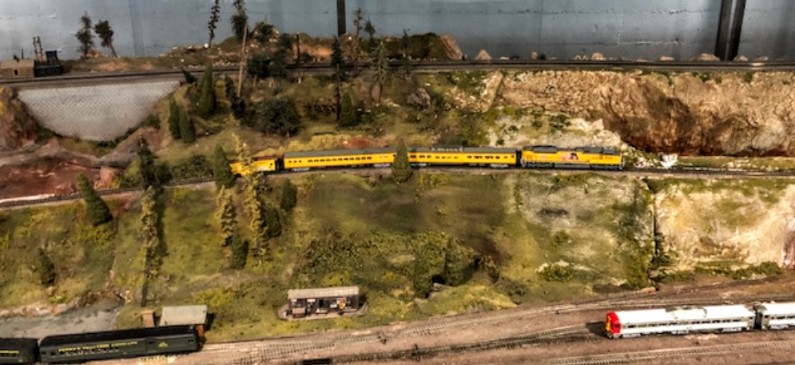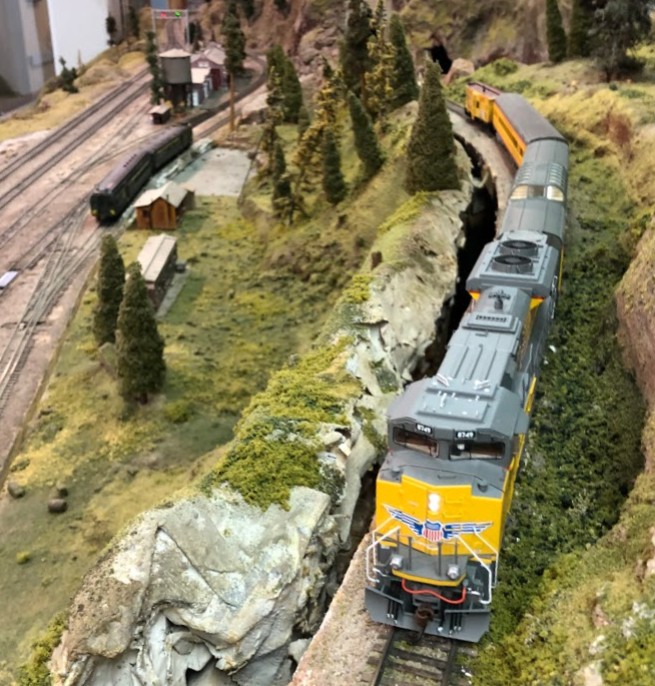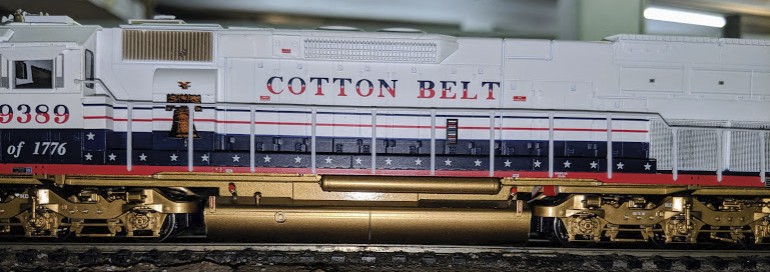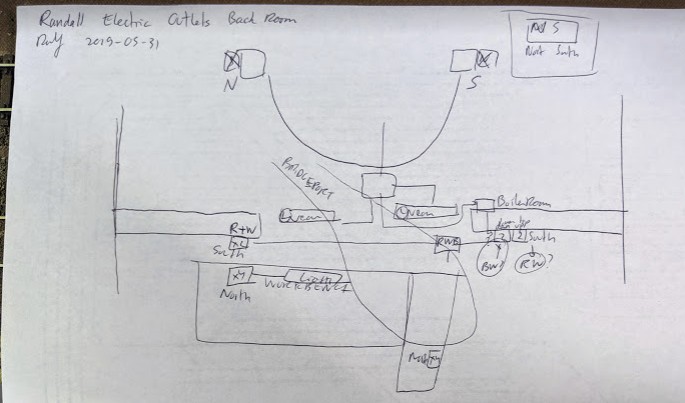The Randall Museum in San Francisco hosts a large HO-scale model railroad. Created by the Golden Gate Model Railroad Club starting in 1961, the layout was donated to the Museum in 2015. Since then I have started automatizing trains running on the layout. I am also the model railroad maintainer. This blog describes various updates on the Randall Museum Model Railroad and I maintain a separate tech blog for all my electronics & software not directly related to Randall.
Affected |
Turnout T410 between Walong and tunnel. |
Description |
Broken point. |
Summary Fix |
Spike the point. |
Description of Issue
The point had broken on turnout T410, causing some engines to derail or get stuck on the rod. William fixed that on the spot by spiking the point. Since the turnout is on the mainline we don’t want trains to get stuck here.
Click here to continue reading...
I enjoy doing cab ride videos on model train layouts. That’s sort of an understatement since I have 17 cab rides now on my channel.
That said, besides just the style, I find cab rides particularly useful as inspection tools. The latest discovery I made is this:
This shows there’s a track feeder soldered to the rails on the inside of the curve, one thing I did not notice when looking at the rails on the spot.
This is particularly useful as this track currently exhibits a rather annoying and elusive dead spot. The track “obviously” has power except when a train comes from the tunnel towards Sultan, where it suddenly loses power. That means now I can crawl under the layout and check whether that track feeder is properly soldered, and I’ll reference that photo to figure the location from under the plywood -- which is never something I’m looking forward to.
Another possibility is that the issue comes from a typical cold solder joint as I already fixed in other places, except I do not know where the next track segment junction is, and this location does not make it easy to access any of the track.
Here’s the full video:
The “Auxiliary Power Supply” is a gray box that used to be located on the other side of the wall behind the automation computer. It has now been moved next to the fascia, just on the other side of the wall where the DCC Power Switch is located. This will make it easier to reset when it trips, which it sometimes does.
It has 3 outputs which provide:
- 24 V DC for the DC / DCC relays.
- 12 V AC for an accessory bus going under the layout, powering various little things (example: tortoise from the branchline, ac-dc converter for the Sonora signal bridge, etc.)
- 6 V AC for … definitely some lights.
The next step is to put a green LED on the front of the power supply. This will make it even more obvious when it has tripped. Also replace the blue painter tape by a proper label. I added the LED but instead went for a contraption like this:
Click here to continue reading...
Affected |
Block B350 up the mountain. |
Description |
Joiner solder gone bad. |
Summary Fix |
Resolder the joiner. |
Description of Issue
We have had elusive electrical issues with block B350 for a little while. Trains would stop when going up or down the mountain. This is likely due to a broken solder in the track power feeds -- as the track warms up or as the trains put pressure on it, it can be enough to make or break the contact and lose power. Or it could be an issue with the track power on the panel with the track toggles, as we had experienced issues with that last year too.
Although it’s easy to get a rough idea of where the trains lose power, it’s a lot harder to get near the track for a close inspection. A lot of these power feed wires are also hidden in the track scenery or ballast.
Click here to continue reading...
2019-08-06 - Track Cleaning
Category RandallHow do we clean the track on this layout?
Turns out it’s a bit of a complicated subject. Take any model train magazine or forum and you’ll get hundreds of different replies, everyone claiming to know better.
I, for one, don’t know any better. I only know what I’ve seen done, and what I tried, with either success or failure. Let’s do a list. Sit down, that’s going to be a long story.
Click here to continue reading...
Lately the automation has been partially stopped due to this:
The automated UP passenger train stops in the middle of the grade going up to Summit. No electrical power.
Click here to continue reading...
TEMPLATE TO BE EDITED
Affected |
Turnout T06 on mainline in front of Stockton Yard. |
Description |
Shorts mainline when thrown. |
Summary Fix |
Fixed itself, could not identify issue. Likely loose wiring or bad solder. |
Description of Issue
Recently turnout T06 had been out of commission. When throwing it, it would short the mainline. On the layout track plan, this turnout is part of a mainline cross-over in front of the Stockton Yard, which is fairly frequently used by the Saturday Operators -- they can build their train on mainline track #2 and then use that turnout to get it out on mainline track #1, for example.
Usually when I repair something, I made a protocol of documenting what was wrong and how it was fixed. My goal when doing so is to build documentation over time, as well as document changes to the layout. We really lack up-to-date documentation on the technical aspects of the layout besides the few schematics I got from Mr. Perry.
Click here to continue reading...
Today was another cleanup day. Mr. Morgan was here and helped me clean Napa quite a bit.
While he was doing this, I was trying to get this running for Jim, as detailed on the train blog page:
Click here to continue reading...
Jim got this engine for Randall in commemoration of the 150th Anniversary of the Transcontinental Railroad, and he ran it on the layout multiple times:
I had some issues with power pickup with this so I decided to toy a bit with it.
You can read the details on the train blog page.
The other day the back room had no power, while seemingly the rest of the layout had some. I don’t know if there are electrical schemas around -- I certainly don’t have any -- so I decided I’d document that and make a schema myself. Since I’m not an electrician, I need to look up how these folks draw their schemas first. In the meantime I compiled this:
Click here to continue reading...







